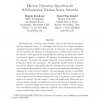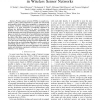206 search results - page 23 / 42 » A probabilistic approach to inference with limited informati... |
ADHOC
2006
13 years 9 months ago
2006
Self-organization of wireless sensor networks, which involves network decomposition into connected clusters, is a challenging task because of the limited bandwidth and energy reso...
ROBOCOMM
2007
IEEE
14 years 3 months ago
2007
IEEE
Abstract—Robust, dependable and concise coordination between members of a robot team is a critical ingredient of any such collective activity. Depending on the availability and t...
JSAC
2010
13 years 3 months ago
2010
Abstract--Sensor networks can benefit greatly from locationawareness, since it allows information gathered by the sensors to be tied to their physical locations. Ultra-wide bandwid...
GLOBECOM
2009
IEEE
14 years 3 months ago
2009
IEEE
Abstract—Wireless sensor networks (WSNs) are usually missioned to gather critical information in hostile and adversarial environments, which make them susceptible to compromise a...
IROS
2008
IEEE
2008
IEEE
HybridExploration: A distributed approach to terrain exploration using mobile and fixed sensor nodes
14 years 3 months ago
— When an emergency occurs within a building, it may be initially safer to send autonomous mobile nodes, instead of human responders, to explore the area and identify hazards and...


